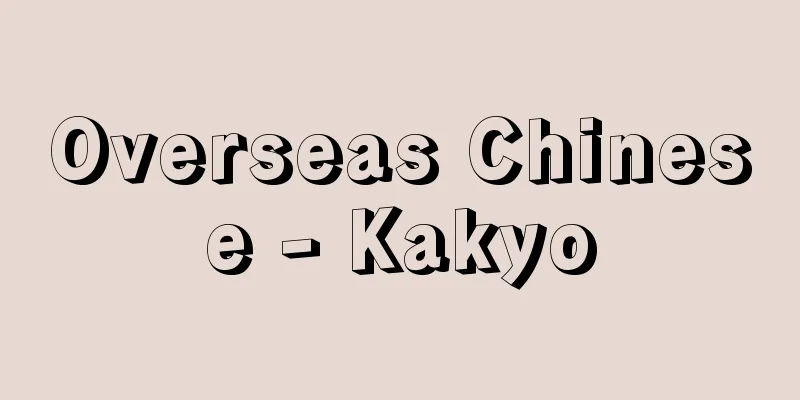Overseas Chinese - Kakyo

|
The term overseas Chinese is originally a general term for overseas Chinese (people who have Chinese nationality and live privately in lands or countries outside of China for a long period of time). After World War II, the standard kanji for Japanese was established, and the character "qiao" was removed from the standard kanji for overseas Chinese, so the media began to use "huashang" as a colloquial term for overseas Chinese. The feeling of the word and the character "shang" was transferred directly to the Chinese expression "huashang," and the image of overseas Chinese as "huashang" began to take root in Japanese, giving rise to illusions and misunderstandings. "Overseas Chinese" is originally a Chinese word, with "hua" coming from the Chinese word "hua" meaning China, and "qiao" coming from the Chinese word "qiao" meaning "temporary residence" or "qiaomin" meaning "temporary residence," and it can be said to be an abbreviation of the combination of these two. [Dai Guohui] The formation of overseas Chinese societyThe history of Chinese overseas migration can be roughly divided into two periods. (1) Before the Opium Wars (1840-1842) China was one of the four great civilizations of ancient times, and Chinese civilization enjoyed great superiority until the early modern period. As a result, the history of exchanges between the Chinese and other countries can be traced back quite far. However, the cultural exchange surrounding Buddhism that occurred from the Jin to Tang dynasties, the tribute trade that took shape in the Tang and Song dynasties, and the economic exchanges centered on Arabian merchants who began to visit China more frequently did not lead to the creation of overseas Chinese. The initial presence of overseas Chinese was brought about by overseas expeditions by the Yuan and mid-Ming dynasties (the most famous being the Southeast Asian expedition by Emperor Shizu of the Yuan dynasty and the seven expeditions to the South Seas by Emperor Zheng He of the Ming dynasty) and the participation of "unruly" Chinese in the form of wako pirates. The expeditionary forces and those related to the wako who remained in the area were, so to speak, the original overseas Chinese. Furthermore, collective, genuine overseas migration of Chinese people began at the end of the Ming Dynasty. In particular, after the Ming Emperor Muzong (reigned 1567-1572) opened up the tally trade to the public as a measure against wako pirates, trade with the South Seas became even more active, and Chinese people gradually began to migrate and settle there to make a living, i.e., the formation of an overseas Chinese society began. Then, under pressure from the Qing Dynasty, which had entered the country, people associated with the Ming Dynasty moved south and fled overseas en masse, creating the peak period for the formation of overseas Chinese society before the modern era. However, from the end of the Ming Dynasty until the beginning of the Qing Dynasty, the means of maritime transport was "junks" that relied on the seasonal winds, so the volume was not significant. (2) From the Opium Wars to the Present In modern times, many of the overseas Chinese who have been mentioned are people who migrated or went to work overseas around the time of the Opium Wars and later, but stayed in their home country (country), and their descendants. Overseas Chinese and overseas Chinese society have been nurtured from the intersection of historical, political, social, and economic circumstances in both China, the sending side, and the receiving side, the receiving country (country). In other words, they are a product of world history. The most famous of these is the migration through the so-called coolie trade. The coolie trade is also called pig trade in English. Pig is the Cantonese word for piglet. The word originates from the fact that people mocked pigtails, crammed them like livestock, and transported them in large numbers to Asia and the Americas on the decks or in fourth-class cabins of steamships. What created the inhumane circumstances of the "Pigs" was none other than the political corruption of the Qing Dynasty and the resulting economic exhaustion, which was exacerbated by the Western Impact led by Britain and the invasion of China by the Western powers, starting with the Opium Wars. The rural societies of southern China, which were forced to disintegrate by the Opium Wars and other events, naturally produced a large number of refugee peasants. Awaiting these refugee peasants was the colonialism of the Western powers. At the time, Western capitalism was on the path to the full bloom of industrial capitalism. Colonies were divided up and competed for monopoly, and in parallel with this, colonial development progressed at a rapid pace. Until then, the workers brought in from outside the colonies were mainly black workers from the African continent. However, with the colonization of the African continent itself and the successive implementation of emancipation decrees (Britain in 1833, France in 1848, Peru in 1855, America in 1860, Holland in 1863, Spain in 1870), cheap labor sources began to dry up or disappear. Demand for replacement labor for black slaves arose on a global scale. Refugee peasants from South India, created by British colonial rule, and refugee peasants from China, whose main source of migration was southern China, emerged as the main source of replacement labor. The word "coolie" comes from the English word "coolie," and its English origin can be traced back to the Hindi word "kuli" or the Tamil word "kuli." First Indian coolies, then Chinese coolies, were brought to South Africa, the West Indies (especially Cuba), the United States, Canada, Peru, British Guiana (now Guyana), Panama, Australia, Hawaii, Southeast Asia, and other places to work on sugarcane and other plantations, develop jungles, mine gold and tin, and lay railways. This became the famous "pig trade." The early overseas travel of coolies (especially to Southeast Asia) was by no means based on fair and free contracts. Rather, European immigration companies and coolie traders went to the main export ports of coolies - Xiamen, Shantou, Canton, Hong Kong, and Macau - and used Chinese crooks (also called coolie heads or pig heads) who were subcontracted by them to kidnap or deceive refugee peasants who were suffering from financial difficulties, tie them to the deck or the bottom of a ship, and then force them to go. In the overseas countries, they faced unfamiliar climates and environments, and endemic diseases such as malaria, and they endured these harsh conditions while doing manual labor as "hardworkers". Some of the coolies eventually became small merchants and were incorporated into the colonial system as middlemen between the colonizers and the colonized, gradually creating an overseas Chinese society. Relatives and acquaintances flocked to this pioneer society in droves, seeking connections, and the large and unique "outsider" society that we see today was formed. [Dai Guohui] Agony and contradictions from overseas Chinese to Chinese peopleAs long as overseas Chinese remain overseas Chinese, that is, as long as they remain migrant Chinese living in temporary housing, most of them dream of "returning home in brocade" and generally live by the principle of "falling leaves and returning to the roots, eventually returning to the place of their ancestors' graves" and make a living in their place of residence (country). However, after the end of World War II, major changes occurred in both the place of residence (country) of overseas Chinese and the country of their ancestors, the political and economic systems of mainland China, and the international relations surrounding both. The place of residence (country) became an independent country from a colony, while the homeland of their ancestors went through the Chinese Civil War and emerged as a socialist China. Overseas Chinese were forced from both inside and outside the country to break away from their previous "rootless" and "middleman" lifestyle. The changed mainland China, with its ideology and political system, was no longer the country on which the descendants of overseas Chinese should base their political and legal identity (belonging). For the descendants of overseas Chinese, mainland China was becoming a place where "the motherland was far away and not a place to live." In the international environment until the early 1970s, where the Cold War between the United States and the Soviet Union, the intensifying East-West conflict, and the US policy of containing China continued to run as undercurrents, they fell into a deep dilemma about what to do with themselves. While changing the principle of their lives to "taking roots in the place where they live" (taking roots in the place where they live), they entrusted their dream of a life to "flowering and bearing fruit" (after taking root in the place where they live, blooming and bearing fruit), and began to search for a way to survive to replace the previous "returning home in brocade." Around the time when many of the places where they lived were rising as independent nations, the Chinese Communist Party took control of the government in Beijing in the ancestral country of the overseas Chinese, and changed the country's name to the People's Republic of China. The Kuomintang government, which chose the name of the country as the Republic of China, was based in Taiwan, across the Taiwan Strait. Forced to choose a political and legal identity for their "existence", the overseas Chinese had no choice but to choose the citizenship and nationality of the country where they lived, as far as circumstances permitted. In other words, they chose the path from overseas Chinese to Chinese. Chinese is a term that overseas Chinese consciously chose to use to describe themselves after they acquired the nationality and citizenship of the country they live in. Examples of self-appointments in English include Chinese-American and Malaysian Chinese origin. Translated into Japanese, they would be American Chinese (in Chinese, Mei-ji-huaren) and Malaysian Chinese (in Chinese, Malay-seer-huaren). What they are trying to convey is that they are no longer rootless people living in temporary housing, nor are they migrant workers who still retain their Chinese nationality. However, the political, economic and social realities surrounding the Chinese in their home countries are harsh. With the sole exception of Thailand, most of the countries in Southeast Asia are emerging nations that have only recently gained independence from colonial rule by Western powers. Politically, therefore, democracy is immature, and in some countries military regimes and dictatorships continue to prevail. Economically, too, they remain bound by the yoke of colonial economic structures, are not fully free from poverty, and there is a strong sense that the maturity of their national economies has yet to be achieved. Socially, a unified language has yet to be established, illiteracy is common, multiple races and ethnicities coexist, and multiple religious and cultural values remain fragmented and neglected. What is even more fatal is that the colonized people, spoiled by colonialism, accept the superiority of whites in every aspect and continue to harbor a deep inferiority complex toward the "modernity" that is dominated by Europe and the United States. In reaction to this, whether it be well-meaning leaders or the privileged classes busy trying to maintain their vested interests, they focus on racial, ethnic and religious conflicts rather than class contradictions, and encourage the people to do the same. As a result, people lose sight of the basic contradictions and become captives of racism, and the angry younger generation is made into fanatical nationalist ideologists who resort to exclusive violent acts. Even such violent acts are widely accepted by society as righteous and heroic actions. The path to transforming from overseas Chinese to Chinese is progressing slowly, even at the cost of a great deal of bloodshed, under the harsh social realities mentioned above. The most notable examples of bloodshed include the September 30th incident in Indonesia (a coup d'état in 1965 that led to the collapse of the Sukarno regime. Many overseas Chinese and Chinese were caught up in this incident, resulting in a considerable number of casualties), the May 13th incident in Malaysia (a racial riot that occurred in Kuala Lumpur in 1969, in which many Chinese were massacred), and the boat people who were dumped into the sea in large numbers after the unification of Vietnam (80% of whom were overseas Chinese and were criticized by Sartre and others as the "Auschwitz of the sea"). A calm analysis or criticism is expected regarding the feelings and thoughts of the native peoples of Southeast Asian countries who support the various acts of persecution, taking into account the historical background and the connection with the colonial legacy. [Dai Guohui] New China and the Overseas ChineseThe international environment surrounding overseas Chinese, especially in Southeast Asia, meant that overseas Chinese were looked down upon as China's fifth column until the US-China rapprochement (which began with US President Nixon's visit to Beijing in early 1972). In particular, the spread of far-left activism during the Cultural Revolution to other parts of the country led to retaliation from Chinese residents. On the other hand, overseas Chinese who returned to China with a passion for rebuilding their homeland, or socialist China, and their families who remained in China were discriminated against because of suspicions about their class origins and "overseas relations" from the Anti-Rightist Movement that began in the summer of 1957 to the Reform and Opening Up policy that was implemented at the end of 1978. [Dai Guohui] End of the Cold War and New TrendsThe rapprochement between the US and China, the recognition of China by Southeast Asian countries, the death of Mao Zedong and the restoration of Deng Xiaoping, the upheaval in Eastern Europe that began at the end of 1989 and the collapse of the Soviet Union, and the most notable of these was the disarmament of the Malayan Communist Party, which was mainly composed of overseas Chinese (an agreement was signed in December 1989). Prior to this, Aquino (Corey), who was elected president of the Philippines in place of Marcos, revealed his Chinese origins. During his first visit to China on April 14, 1988, he visited the Xu family ancestry shrine in Hongjian Village, Longhai County, Fujian Province, the hometown of his great-grandfather Xu Yuhuan, and then went to Beijing. Compared to Marcos, who hid his Chinese ancestry, Catholic Cardinal Jaime L. Sin (1928-2005), the spiritual leader of the movement to overthrow the Marcos regime, has publicly revealed that he was a first-generation Chinese, and Cory has visited the land of his ancestors, which feels like a different era. It is fair to say that the "fear of communism" of people in the country of residence is gradually being cured. It seems that the day has come when overseas Chinese and ethnic Chinese can live without being questioned by others about their "blood" origins or being forced to bear a sense of original sin. [Dai Guohui] Overseas Chinese and Chinese IdentityCurrent issues
It should not be forgotten that Vietnam, a latecomer to ASEAN (Association of Southeast Asian Nations), achieved high economic growth of over 6% on average in the 1990s after implementing the reform and opening-up policy (Doi Moi, or renewal). Cambodia, another country in the Mekong River basin, is finally beginning to show signs of political stability, and joined ASEAN in April 1999. In addition to the former overseas Chinese who fled the country during the launch of the 10-nation ASEAN system and the Indochina Revolution, overseas Chinese capital from Singapore, Taiwan, Thailand and other countries has flocked into the region. This indicates the formation of an entirely new type of "overseas Chinese" society. In Japan, too, the labor shortage and the drastic relaxation of policies for accepting international students have led to a phenomenon of young immigrants from mainland China becoming "overseas Chinese" or "Chinese people." On the other hand, the reality is that social problems surrounding the new "overseas Chinese" from the mainland are also occurring frequently. The wisdom of "accepting or excluding" them can be said to be a litmus test for measuring the internationalization of Japanese society. (2) The validity of the Asian flying geese economic development model Until the early 1990s, the terms (A) developmental dictatorship and (B) the flying geese development model with Japan at the forefront were often used to interpret the high economic growth of Asia up until the early 1990s. The model refers to the high economic development model of East and Southeast Asia from the mid-1980s to the mid-1990s in particular. This expression refers to the flying geese pattern of "Japan at the forefront, followed by the Asian Newly Industrializing Economies (Asia NIES) of Taiwan, South Korea, Hong Kong, and Singapore, followed by ASEAN countries such as Thailand, and mainland China." (A) has faded due to the general trend toward democratization in Asia. The remaining (B) is also questionable in its continued validity, due to the Asian currency and economic crisis that suddenly hit Thailand, Indonesia, Malaysia, and other countries in July 1997, and the slow recovery from Japan's bubble economy. (3) China and Taiwan's simultaneous accession to the World Trade Organization (WTO) and the great development of China's western region Political reconciliation between North and South Korea and the easing of tensions across the strait are prerequisites, but the economic challenges are the further deepening of reform and opening up, particularly the economic management after China and Taiwan's accession to the WTO in November 2001, and the start of the development of China's western region. Accession to the WTO is expected to be a new starting point for reform and opening up. The development of China's western region will be promoted by the launch of the 10-member ASEAN system (April 1999) and the improvement in US-Vietnamese relations, symbolized by US President Clinton's first visit to Vietnam (November 16-19, 2000). These will expand to the three Indochinese countries centered on the Mekong River basin, and even to neighboring Myanmar. It is worth recalling that the countries in this region were once economic stages for overseas Chinese and Chinese people. It should also be noted that former Vietnamese Chinese who left on boat people are being relocated, and that overseas Chinese and Chinese entrepreneurs in Southeast Asia are teaming up with Taiwanese companies to expand into the three Indochina countries. [Dai Guohui] Issues and prospects in each countryThe situation of the so-called Chinese society and overseas Chinese clearly differs depending on the country they live in, and their sense of self also varies widely. Therefore, I don't think it makes much sense to say that there are about 20 million overseas Chinese scattered in Southeast Asia, limited to blood. Most people of Chinese descent who have lived in the country for several generations, and those who were born in the country and did not receive Chinese language education, usually have a weak or no sense of Chineseness. It is natural and logical for former overseas Chinese who have acquired citizenship in the country they live in to seek political and legal identity in the country they live in, not in China. Singapore is a successful example, and Malaysia is a typical example of a country that is trying. In Singapore, the Chinese make up about 77% of the total population, and they hold the political leadership. In Malaysia, the Chinese make up about 32% of the total population, and they continue to maintain a delicate balance, supported by the social power reflected by their population numbers and the economic power that has been cultivated under the colonial system. Although they have political parties centered on Chinese people, they are still being hindered from exercising political power commensurate with their economic power and from enjoying equal civil rights. This is why Chinese people are demanding the revision of the current Bumiputera system (a policy that gives priority to Malays, also known as the Land Child Policy) and the expansion of the right to education in their mother tongue (Chinese). On the other hand, they still try to base their cultural and social identity strongly on Chinese civilization in relation to their origins. For example, among the overseas Chinese, there is a group called the Hakka who are particularly proud of and attached to their origins. The Hakka are a branch of the Han people who speak Hakka, a Chinese dialect, and their ancestors originally lived in the Central Plains in the Yellow River basin. Due to repeated wars, their descendants migrated to Guangdong, Sichuan, Fujian, Jiangxi, and Taiwan, and even went to Southeast Asia, the Americas, Hawaii, and other places to work, becoming overseas Chinese. Prominent figures include Sun Yat-sen, Liao Chengzhi, Deng Xiaoping, and Lee Kuan Yew, who was Singapore's Prime Minister until 1990. The problem in Thailand is unique. Due to centuries of intermarriage (without religious conflict) and the history of the Thai court being tolerant of Chinese political participation, it is not easy to identify who is Chinese. It is foolish to insist on a racial perspective that defines someone as Chinese just because they are one percent Chinese. The Philippines is also a country where intermarriage is relatively advanced. It is meaningless to say that revolutionary Jose Rizal and former president Marcos had Chinese blood and to classify them as Chinese. In fact, the population of Chinese people is said to reach hundreds of thousands. In Indonesia and Vietnam, the issue of dual nationality that has existed since the colonial era has been lingering, and it is not clear who is an overseas Chinese, who is a native Chinese, and who is a native Chinese. On September 10, 1980, the "Nationality Law of the People's Republic of China" was finally promulgated. It will take some time for the legal awareness of those involved to mature, but the creation of a nationality law that the new Chinese side will rely on to distinguish between overseas Chinese and native Chinese is a groundbreaking achievement. As a means of delaying the worsening economic poverty and domestic contradictions, overseas Chinese and Chinese people are the perfect target and are dragged out as scapegoats. Due to the lack of statistics and the limitations of the social and class characteristics of the current political leadership, which does not have the capacity to seek fundamental solutions or cannot be the true bearers of solutions, the concepts of overseas Chinese relations are left ambiguous even in law, and the population figures are also obscured by the old-fashioned "number-filling" method. The political leadership of Southeast Asia, unable to combine a human scale with a long-term perspective to approach the essence of the problem, continues to treat the overseas Chinese as "foreign elements in national integration," "unscrupulous merchants who control the distribution economy and are a major obstacle to the formation of the ethnic economy," "embodiments of Sinocentrism and a group of people with dual personalities who are boundlessly loyal to China," and so on, treating them as nuisances, regardless of whether they are overseas Chinese, Chinese, or of Chinese descent. Of course, the "overseas Chinese" are not entirely blameless. Historically, overseas Chinese were marginalized under the colonial system due to racial and ethnic discrimination, so in order to survive, they made a living by weaving their way between the colonizers and the indigenous colonized. In the process, they committed evil deeds and were forced to work as middlemen to clean up the colonial system's filth. As a result, they were looked down upon and hated. While the overseas Chinese were reluctant to leave their homes in the Sinocentric world, they also felt a sense of superiority over the native society due to their existence as an appendage of modern Western Europe. Under the influence of the colonialists' divide and rule policy, the psychological distance between the natives and the overseas Chinese widened further, and a conflictual structure was eventually created. Even modest efforts to establish basic human rights as a social minority or as a newcomer (in reality, the vast majority are people who have been here for several generations or who were born locally) are viewed with suspicion. As long as this situation continues, the road to becoming Chinese will continue to be full of bloodshed and suffering. From within the Chinese community, which is beginning to provide many talented people in the fields of politicians, lawyers, doctors, teachers, and journalists, we can expect self-help efforts for true Chinese independence. It goes without saying that the results of this self-help effort will eventually have a positive impact on the democratization and modernization of the country in which they live. Furthermore, the relative advantage of overseas Chinese and Chinese residents in the national income distribution caused by racial and ethnic imbalances in the employment structure will be difficult to correct unless the colonial legacy, including the economic structure, is overcome. Only by restricting the occupations of overseas Chinese and Chinese through laws and regulations from above will it be necessary to invite socio-economic stagnation. This is why we expect a fundamental reform of the feudal and colonial socio-economic structure, including the farmland system. There is no other way to overcome the old nature of the overseas Chinese and Chinese economy. [Dai Guohui] Overseas Chinese in JapanAccording to the Immigration Bureau (currently the Immigration Services Agency), there were approximately 460,000 Chinese people living in Japan as of the end of December 2003. This number is increasing every year, with an increase of 190,000 from five years ago. This figure does not include people with Japanese nationality. In 1982, the Immigration Control Act was revised to become the Immigration Control and Refugee Recognition Act, and since then, the number of Chinese people who have obtained permanent residency has been increasing due to continued revisions. Since Japan is adjacent to China, it has been valued as a place of refuge and trade for Chinese people since ancient times. Many of the Chinese who came before the Meiji Restoration were buried as part of the Japanese community under the strong demand for assimilation in Japanese society, and although they are recorded in stone monuments and ancient documents, their descendants are rarely visible as Chinese people. This is the basis for the theory that Japan and China are of the same race and language, and it is also possible to see this as one of the results. It was after the Meiji Restoration that Chinatowns began to appear in distinct forms in port towns such as Yokohama, Kobe, Osaka, Nagasaki, and Hakodate. These included Cantonese people working as foreign sailors, and people from the Sanjiang region (Jiangsu, Jiangxi, and Zhejiang) who played a part in Japanese trade as buyers for Western-style buildings or self-employed businesses. As the port towns prospered, skilled workers for the three sword trades (cooks, seamstresses, and barbers) also flowed in. However, the Meiji government firmly refused to allow low-wage workers into the country as a self-defense measure. After the Sino-Japanese War, Japan colonized Taiwan, and Japanese-Taiwanese traders, students, and conscripted soldiers and civilians came to Japan. The "overseas Chinese" community from Taiwan was formed around them, and currently accounts for about half of the population. Taiwanese doctors active throughout the country are particularly well-known. Later, exiled groups of people related to the "Manchukuo" and "Wang Jingwei" regimes joined, and with their enthusiasm for education, the "overseas Chinese" community in Japan has produced a society of highly educated people that is unmatched anywhere else. Parliamentary democracy in Japan has been gradually maturing since the end of World War II, and the "overseas Chinese" community is small in number, highly educated, and has a high income, so cases of friction have gradually decreased. [Dai Guohui] "The Overseas Chinese: The Invisible China" by Garth Alexander, translated by Sawara Tetsuo (1975, Simul Publishing Co.)" ▽ "The Overseas Chinese" by Dai Guohui (1980, Kenbun Publishing)" ▽ "The Overseas Chinese" (1981), edited and published by the Nihon Keizai Shimbun Inc. ▽ "More About the Overseas Chinese" edited by Dai Guohui (1991, Kobundo) " ▽ "The Overseas Chinese Kingdoms: Key Players in the Pan-Pacific Era" by Sterling Seagrave, translated by Yamada Kosuke (1996, Simul Publishing Co.) [References] | | | | | Act| |Source: Shogakukan Encyclopedia Nipponica About Encyclopedia Nipponica Information | Legend |
|
華僑という語は、本来、在外中国人(中国国籍を保持したまま、長期的に、私的に中国領土外の土地や国に居住する人々)の総称である。第二次世界大戦後、日本では当用漢字が制定され、「僑」の字が当用漢字外の字となったため、マスコミは華僑の言い換え語に華商を俗称として使用してきた。商のもつ語感と字感がそのまま華商の漢語的表現に乗り移って、華僑即華商のイメージが日本語として定着し始め、錯覚と誤解を生んできた。華僑はもともと中国語で、「華」は中国を意味する中華の華、「僑」は僑居(仮住まい)もしくは僑民(仮住まいする人々)の僑からそれぞれとり、その組合せでできた略語といってよい。 [戴国煇] 華僑社会の形成中国人の海外移住史は、おおよそ次の2期に分けてみることができる。 (1)アヘン戦争(1840~1842)以前 中国が古代四大文明国の一つで、中華文明は近世までその優位性をほしいままにしていたゆえに、中国人と外国の交流史はかなり古くまでさかのぼれる。 しかし、晋(しん)から唐にかけてみられた仏教をめぐる文化交流、唐・宋(そう)において原型が整えられる朝貢貿易、来華が頻繁となり始めるアラビア商人、これらを中心とした経済交流は、華僑を生み出すまでには至らなかった。 華僑の初期的存在をもたらしたのは元から明(みん)の中期にかけての、王朝による海外遠征(元・世祖(せいそ)の東南アジア遠征、明・鄭和(ていわ)による7回に及ぶ南海遠征が著名)と、「不逞(ふてい)」中国人の倭寇(わこう)参加だった。遠征軍と倭寇関係者の現地での残留分子がいわば華僑の元祖である。 なお中国人の集団的、そして真正の意味における海外移住は明末をもって始まる。とくに倭寇対策で勘合貿易を民間にも開放した明の穆宗(ぼくそう)(在位1567~1572)以降、中国人の南洋との交易は一段と盛んになり、生活のための移住と定着、すなわち華僑社会の形成が徐々に始まる。続いて入関した清(しん)朝の圧迫で、明朝関係者の南遷と集団的海外避難が起こり、近代以前の華僑社会形成のピーク期をつくりあげる。だが明末清初までの海上交通の手段は季節風に頼る「ジャンク」だったので、量的にはたいしたものではない。 (2)アヘン戦争前後から今日まで 近代以降、華僑として話題になる人々の多くは、アヘン戦争前後以降に海外へ移住もしくは出稼ぎに行ったまま、居住地(国)にとどまった人およびその末裔(まつえい)である。華僑ならびに華僑社会は、押し出す側の中国と受け入れる側の居住地(国)の双方における、歴史的な、あるいは政治、社会、経済的状況の交差のなかからはぐくまれてきた存在である。ことばをかえれば、世界史的所産といえる。そのうちでもっとも著名なのはいわゆる苦力(クーリー)貿易による移住である。苦力貿易は英語でピッグ・トレードpig tradeともいう。pigは広東(カントン)語でいう「猪仔(ツウチァイ)」(ブタの子の意)である。弁髪をpig tailとあざ笑い、家畜同様ぎゅうぎゅう詰めにして蒸気汽船の甲板または4等船室で大量にアジア、アメリカ大陸へ運んだことが語源といわれる。「猪仔」の非人間的境遇をつくりだしたのは、ほかでもない清朝統治の政治的腐敗と、それに伴う経済的疲弊、これに拍車をかけたイギリスをはじめとするウェスタン・インパクト、アヘン戦争を手始めとした西欧列強の中国侵略である。アヘン戦争などで解体を余儀なくさせられた華南一帯の農村社会は、当然のことながら多数の流亡農民を生み出した。これら流亡農民を外で待ち受けていたのは、西欧列強の植民地主義だった。当時西欧資本主義は産業資本主義の満開への道程にあった。植民地の分割と独占への角逐、それに並行して植民地開発は急ピッチに展開した。 それまで植民地外から導入される労働者は主としてアフリカ大陸の黒人労働者だった。しかしアフリカ大陸自体の植民地化、さらには相次ぐ奴隷解放令の実施(イギリスは1833年、フランスは1848年、ペルーは1855年、アメリカは1860年、オランダは1863年、スペインは1870年)で、安い労働力源は枯渇または喪失をみせ始めた。黒人奴隷の代替労働力への需要が世界的規模において生じてくる。イギリスの植民地支配で生み出された南インドの流亡農民と、華南をおもな流出源とする中国の流亡農民が、その代替労働力の主たるものとして浮かび上がる。苦力(クーリー)は英語のcoolieから、その英語の語源はさらにヒンディー語のkuliあるいはタミル語のkuliに求められる。サトウキビ畑などの農園、ジャングルの開発、金・錫(すず)鉱山の採掘、鉄道の敷設労働者として、初めはインド人のクーリーが、続いて中国人の苦力が南アフリカ、西インド諸島(とくにキューバ)、アメリカ、カナダ、ペルー、英領ギアナ(現、ガイアナ)、パナマ、オーストラリア、ハワイ、東南アジアなどに導入、連行された。これが史上有名な「ピッグ・トレード」である。 初期の苦力の海外渡航(なかんずく東南アジア向けの場合)はけっして公明正大な自由契約に基づくものではなかった。むしろヨーロッパ系の移民会社、苦力貿易業者が苦力のおもな輸出港――厦門(アモイ)、汕頭(スワトウ)、広東(カントン)、香港(ホンコン)、マカオにまで出向いてきて、その下請けをした中国人奸商(かんしょう)(苦力頭または猪仔頭ともいう)を使って、生活苦にさいなまれていた流亡農民を誘拐したり、ごまかしたりして、甲板や船底につなぎ、そして押し込む形で連行した。現地では、慣れない気候と風土、マラリアなどの風土病が待ち受け、彼らはそれらの悪条件に耐えながら「苦工」という力仕事をこなしていた。苦力の一部はやがて小商人となり、植民者と被植民者のミドルマン的存在として植民地支配体制に組み込まれ、華僑社会が徐々にできあがる。この先行者社会につてを求めて親戚(しんせき)、縁故者らが続々と詰めかけ、今日みられる大量でそしてユニークな「よそ者」社会が形成された。 [戴国煇] 華僑から華人への苦悶と矛盾華僑が華僑であり続ける間、すなわち仮住まいで出稼ぎの中国人であり続ける限り、彼らのほとんどが「衣錦(いきん)還郷」(錦(にしき)を飾って故郷に帰る)を夢に、そして「落葉帰根」(葉が落ちて根っこに戻る、いずれは父祖の墳墓の地に帰る)を生活原理にして居住地(国)において生業を営むのが一般である。しかし第二次世界大戦の終戦を境に、華僑の居住地(国)と彼らの父祖の国、中国大陸の政治・経済体制と両者を取り巻く国際関係の双方に大変動が訪れる。居住地(国)は植民地から独立国に、父祖の故郷(国)は国共内戦を経て社会主義中国が姿を現す。華僑は、それまでの「根なし草」的、「ミドルマン」的生き方からの脱皮を、強く内外から迫られる境地に追い込まれていった。変化した中国大陸は、そのイデオロギーと政治体制からして、もはや華僑の末裔の政治的、法律的アイデンティティ(帰属)の拠(よ)るべき国ではなくなってくる。中国大陸はまさに、華僑の末裔にとって「祖国は遠くにありて思うもの、住むべき所にあらず」の存在となりつつあった。米ソの冷戦体制、激化する東西対立、アメリカの中国封じ込め政策が底流として流れ続けた1970年代初頭までの国際環境下で、彼らは身の処し方をめぐるディレンマに深く陥る。彼らは生活の原理を、「落地生根」(居住地に根づいていく)に変えながら、生活の夢は「開花結実」(居住地に根づいたあと、花を開かせ実を結ばせる)に託し、それまでの「衣錦還郷」にとってかわるべく生き残る道を模索し始める。 居住地の多くが独立国として立ち上がったころ、華僑の父祖の国では、中国共産党が北京(ペキン)で政権を掌握し、国号を中華人民共和国に変えていた。なお中華民国を国号に定めた国民党政権は、台湾海峡を渡って台湾に拠る状況である。政治的、法律的アイデンティティの選択を自分たちの「実存」絡みで迫られた華僑たちは、事情が許す限り、居住国の市民権、国籍を選ばざるをえなかった。つまり彼らは華僑から華人への道を選んだのである。 華人とは、華僑が居住国の国籍、市民権を取得したのち、自己を表現するにふさわしい自称として意識的に選び取ったことばである。英語での自称の例としてChinese-AmericanとかMalaysian Chinese originなどが使われるようになってきている。それを日本語に訳すと、米国籍華人(中国語では美籍華人)、マレーシア国籍華人(中国語では馬来西亜籍華人、華裔馬来西亜人)となろう。いわんとするところは、自分たちは仮住まいの根なし草的存在ではないし、中国国籍を保持したままの出稼ぎ人ではもはやない、ことにある。 だが華人を取り巻く居住国の政治、経済、社会的環境の現実は厳しい。東南アジア諸国のうち、タイ国が唯一の例外であるほかは、ほとんどの国が欧米列強の植民地支配から独立して年月の浅い新興国家である。したがって、政治面においては民主主義は未熟で、国によっては軍事政権、独裁政権が続いている。経済面においても植民地的経済構造のくびきにいまなおつながれたままで、貧困から十分に自由でなく、国民経済の成熟度はあと一歩の感が深い。社会面では統一言語の未確立と非識字者の普遍的存在、多元的な人種・民族の併存、多元的宗教と文化の諸価値が、ばらばらと放置されたままになっている。 より致命的なことは、植民地主義によってスポイルされた被植民者大衆は、白人のあらゆる面での優位性を受け入れ、欧米を主流とした「近代」への劣等感を深く抱き続けていることである。その反動として、心ある指導者、既得権益を保持しようとあくせくしている特権階級のいずれを問わず、階級矛盾よりは、人種、民族、宗教上の対立面に目を向け、民衆にもそのように仕向ける。その結果、人々は基本的矛盾を見失い、人種主義のとりことなり、怒れる若い世代は狂信的な国粋的民族主義者に仕立てあげられ、彼らは排他的暴力行為に走る。その暴力ざたさえも正義ある英雄的行動として幅広く社会的には受け入れられる。 華僑から華人への自己脱皮の道は、先にあげた厳しい社会的現実のもとに、おびただしい流血を代償にしてなお遅々として進まない状況である。流血の最たる事例は、インドネシアの九月三〇日事件(1965年、スカルノ体制崩壊につながったクーデター事件。この事件に多くの華僑・華人が巻き込まれ、かなり多数の犠牲者が出たという)、マレーシアの五・一三事件(1969年、クアラ・ルンプールで起こった人種暴動事件。華人が多数虐殺された)と、ベトナム統一後、大量に海にほうり出されたボートピープル(その8割が華僑・華人系であり、サルトルらはこれを「海のアウシュウィッツ」と批判した)をあげることで十分だろう。数々の迫害行為を支える東南アジア諸国のネイティブ(先住民)の感情や思考に関して、歴史の背景ならびに植民地遺制との連関を踏まえて、冷静な分析あるいは批判が期待される。 [戴国煇] 新中国と華僑・華人華僑・華人をめぐる国際環境、なかんずく東南アジアでの状況は米中接近(1972年初めアメリカ大統領ニクソンの北京訪問で開始)まで、「華僑」は中国の第五列と白眼視されていた。とくに、文化大革命期における極左派行動の域外への波及で居住国民からの反撃を受けることも少なくなかった。他方、社会主義中国=祖国再建の熱情で帰国した帰国華僑と海外華僑の国内留守家族は、1957年夏に始まった反右派闘争から1978年末に実施をみる改革開放政策まで、彼らの出身階級と「海外関係」に疑いがかけられ差別された。 [戴国煇] 冷戦体制の終結と新動向米中接近、東南アジア諸国の中国承認、毛沢東(もうたくとう/マオツォートン)の死と鄧小平(とうしょうへい/トンシヤオピン)の復権、1989年末に始まる東欧の激動とソ連解体、なかでも軽視できないのは、華僑・華人が主体のマラヤ共産党が武装解除(1989年12月に協定調印)したことである。これに先駆けてフィリピンでマルコスにかわって大統領に当選したアキノ(コリー)が自らの華裔(かえい)的出自を明らかにした。そして、1988年4月14日の中国初訪問に際しては、大祖父許玉寰(きょぎょくかん)の故郷福建(ふっけん/フーチエン)省龍海(りゅうかい/ロンハイ)県鴻漸(こうぜん/ホンチェン)村の許氏宗祠(そうし)を参拝して、その後北京入りした。マルコスが自らの華裔的血筋を隠したのに比べ、マルコス政権打倒の精神的リーダーでカトリック教会枢機卿(すうききょう)のシン(辛)Jaime L. Sin(1928―2005)が華人一世であることを公開したことや、コリーの父祖の地訪問など、隔世の感がある。居住国関係者の「恐共病」が癒(いや)されつつあるといっていいであろう。 華僑・華人が他者に「血」の出自を問われ、原罪意識を強制されることなく生活できる日が訪れてきたようである。 [戴国煇] 華僑・華人のアイデンティティ当面の問題
忘れてならないのは、ASEAN(アセアン)(東南アジア諸国連合)の後発国ベトナムが改革開放政策(ドイモイ=刷新)を導入して以来、1990年代の経済成長率平均6%以上という高成長を遂げたことである。メコン川流域のもう一つの国カンボジアもやっと政局安定の兆しがみえ始め、1999年4月にはASEAN加盟を果たした。ASEAN10か国体制の発足とインドシナ革命時に国外脱出した旧華僑・華人に加えて、シンガポール、台湾、タイなどの華僑・華人資本が大挙して同地域に進出した。これは、まったく新しい形の「華僑」社会の形成を示している。 日本においても、労働力不足や留学生受入れ政策の大幅な緩和に伴って若年知識労働者的性格をもった中国大陸からの移住者を中心に「華僑・華人」化現象が起きている。反面、大陸からの新「華僑」をめぐる社会問題もまた頻発しているのが実状である。彼らをめぐっての「受容か排除か」の知恵が日本社会の国際化をはかるリトマス試験紙ともなっているといえよう。 (2)アジア雁行(がんこう)的経済発展モデルの有効性 (3)世界貿易機関(WTO)への中・台同時加盟と中国の西部大開発 [戴国煇] 居住国それぞれの問題と展望いわゆる華人社会や華僑とよばれる人々の置かれている状況は、各居住国によって明らかに異なり、主体的意識もまた多岐に分かれている。したがって、血に限定した形で「東南アジアには『華僑』が約2000万散在している」といった表現はあまり意味があるとは思えない。居住歴が数世代に及ぶ華裔(かえい)、居住地生まれで華語(中国語)教育を経ていない人々の大半は中国人意識が希薄か、もしくは有しないのが通常である。元華僑で居住国国籍を取得した華人は、政治的、法律的アイデンティティを、中国ではなく居住国に求めるのは当然で、理にかなったことでもある。その成功例がシンガポールで、努力中の典型はマレーシアにみいだせる。シンガポールでは華人が総人口の約77%を占め、政治的主導権も彼らの掌中にある。またマレーシアにおいては総人口の約32%を占める華人が、人口数によって反映される社会力と植民地体制下ではぐくまれてきた経済力に支えられて、ある種の均衡を微妙に保ち続けている。彼らは華人中心の政党をもっているが、経済力にふさわしい政治力の行使と、市民的諸権利の平等な享受は、なお妨げられている。華人らが現行のブミプトラ(土地っ子政策といわれるマレー人優先政策)の修正と、母語(華語)による教育権の拡大を要求しているゆえんである。 一方、彼らは自らの文化的、社会的アイデンティティをなおも自らの出自との関連で中華文明に強く拠ろうと試みる。たとえば「華僑」のなかで、優れて自らの出自に誇りとこだわりをもち続けているグループに客家(ハッカ)の人たちがいる。客家は中国の方言の一つである客家語を話す漢民族の一分支で、先祖はもともと黄河流域の中原(ちゅうげん)に住んでいた。たび重なる戦乱のあおりで子孫は広東(カントン)、四川(しせん/スーチョワン)、福建(ふっけん/フーチエン)、江西(こうせい/チヤンシー)、台湾に移住、さらには東南アジア、アメリカ大陸、ハワイなどに出稼ぎに行き、華僑化した。その傑出した人物に孫文(そんぶん/スンウェン)、廖承志(りょうしょうし/リヤオチョンチー)、鄧小平(とうしょうへい/トンシヤオピン)、1990年までシンガポールの首相であったリー・クアン・ユーなどがいる。 なお、タイでの問題は特異である。過去数世紀にわたる混血(宗教上の軋轢(あつれき)がない)と華人の政治的参加に寛容であったタイの朝廷の歴史が重なり合って、だれが華人であるかの識別は容易ではない。何分の一の血を継承しているゆえに華人をうんぬんする人種的視角に固執するのは愚行の一つでしかない。 フィリピンも混血が比較的に進んでいる国である。革命家ホセ・リサールと元大統領マルコスに華僑の血が流れているといって彼らを華人の範疇(はんちゅう)に入れる方式は意味あることではあるまい。事実その華裔人口は数十万人にも達するといわれる。インドネシアとベトナムは旧植民地時代以来の二重国籍問題が尾を引いていて、だれが華僑で、だれが華人で、だれが華裔であるかが明らかではない。1980年9月10日、ようやく「中華人民共和国国籍法」が公布された。関係者の法意識の成熟には時間がなお必要だろうが、華僑と華人の区別に新中国側の依拠する国籍法ができたのは、画期的なことである。 経済的貧困と国内矛盾の激化の引き伸ばし策として華僑・華人はかっこうの素材であり、スケープゴートとして引きずり出される。統計の未整備と、根本的解決策を模索する余裕がないか、もしくは解決の真の担い手たりえない現政治指導層の社会的、階級的性格の限界もあって、華僑関係の諸概念は法律的にもあいまいのまま放置され、その人口数もまた旧態依然の「数合わせ」でお茶をにごしている始末である。 人類的スケールと長期的展望を組み合わせて問題の本質にアプローチできないままの東南アジア政治指導層は、いまなお華僑問題を「国民統合での異分子=よそ者」、「流通経済を牛耳(ぎゅうじ)る悪徳商人で、民族経済=国民経済形成の主要な阻害者」、「中華思想の体現者で、限りなく中国に忠誠を尽くそうとする二重人格者集団」などと、華僑、華人、華裔の区別なくじゃま者扱いにしている。もちろん「華僑」側に全然非がないわけではない。そもそも華僑は歴史的に、植民地体制下で人種・民族的差別によって疎外された人々であるゆえ、生きるために、植民者と土着被植民者の間隙(かんげき)を縫って生業を営んできた。その過程で悪業も、そしてミドルマンとして植民地主義の悪(あ)しき汚物処理の係員として働かせられた。その結果、白眼視され、憎悪の対象となる。「華僑」らは、中華思想に後ろ髪を引かれるかたわら、西欧近代の付属物的存在であったことで、ネイティブ社会に優越感を抱いた。植民者の分割支配政策の影響下で、ネイティブと「華僑」の心理的距離は一段と拡大され、対立抗争の構図が最終的にはつくられた。 社会的少数派としての、もしくは新参(事実は、数世代以来の、もしくは現地生まれの人々が圧倒的多数を占める)の市民としての基本的人権の確立を求める控え目な営為さえ疑惑の目で見られる。この状況が続く限り、華人への道はなお流血と苦悩に満ちたものであり続けるだろう。政治家、弁護士、医師、教師、ジャーナリストの分野にも多くの人材を提供し始めている華人社会の内側から、華人の真なる自立への自助努力が期待される。この自助努力の成果は、やがて居住国の民主化、近代化にもよき影響を与えるのは指摘するまでもない。なお、就業構造の人種的、民族的アンバランスによって生ずる華僑・華人系住民の国民所得分配での相対的優位性は、経済構造を含む植民地遺制を克服しない限り是正は困難である。上からの法令による華僑・華人への職業制限だけでは社会経済的停滞をいたずらに招くのが落ちであろう。農地制度をはじめとする封建的、植民地的社会経済構造の抜本的改造が期待されるゆえんである。それ以外に華僑・華人経済の古い体質の克服の道はない。 [戴国煇] 日本の華僑・華人入国管理局(現、出入国在留管理庁)によると、日本には2003年(平成15)12月末で在日中国人が約46万人いる。5年前の19万人増で年々増加している。この数字には日本国籍をもつ人々は含まれていない。1982年(昭和57)「出入国管理令」が改正されて「出入国管理および難民認定法」となり、それ以後も改正が続けられたことで、永住権取得者が増える傾向にある。隣接するゆえに、古来、日本は中国人の避難の地、貿易の地として重宝がられてきた。明治維新以前の渡来者は、日本社会の強烈な同化要請下で多くは日本人の一員として埋没し、石碑や古文献にこそ記録されるが、華裔として子孫が顕在化することは少ない。日中同文同種論の拠るところであり、その結果の一つとしてみることもまた可能である。横浜、神戸、大阪、長崎、函館(はこだて)などの港町に唐人街(チャイナタウン、中華街)が明確な形で現れるようになるのは明治維新以降である。外国船員として活躍する広東省人、洋館の買弁(ばいべん)もしくは自家営業として日本貿易の一翼を担った三江(江蘇(こうそ/チヤンスー)、江西(こうせい/チヤンシー)、浙江(せっこう/チョーチヤン))出身者がいる。港町の繁栄に伴って三刀業者(コック、裁縫師、床屋)の熟練労働者もまた流入した。ただし明治政府は自衛策のため低賃金労働者の入国は堅く拒んだ。 日清(にっしん)戦争後、日本が台湾を植民地化したので、日台貿易業者、留学生、徴用(軍人・軍属)関係者などが来日した。彼らを主流に台湾出身「華僑」社会が形成され、その数は目下約半数を占め、津々浦々で活躍する台湾人医師はとくに著名である。その後「満州国」「汪兆銘(おうちょうめい/ワンチャオミン)政権」など関係者の亡命グループも加わり、教育熱心もあって、在日「華僑」社会は他にはみられないほどの高学歴者社会を生み出している。第二次世界大戦後日本での議会制民主主義が徐々に円熟化しつつあり、「華僑」社会が少人数で高学歴かつ高所得でもあるので、軋轢(あつれき)のケースはしだいに減少してきた。 [戴国煇] 『ガース・アレキサンダー著、早良哲夫訳『華僑・見えざる中国』(1975・サイマル出版会)』▽『戴国煇著『華僑』(1980・研文出版)』▽『日本経済新聞社編・刊『華僑』(1981)』▽『戴国煇編『もっと知りたい華僑』(1991・弘文堂)』▽『スターリング・シーグレーブ著、山田耕介訳『華僑王国――環太平洋時代の主役たち』(1996・サイマル出版会)』 [参照項目] | | | | | | |出典 小学館 日本大百科全書(ニッポニカ)日本大百科全書(ニッポニカ)について 情報 | 凡例 |
<<: Task - Kagyo (English) task
Recommend
Dehydrogenase - Dassuisokoso
Also called dehydrogenase. A type of oxidoreducta...
Elementary charge - Electric charge
Also known as elementary charge. The smallest unit...
Si-tu Mei-tang (English name)
[Life] Tongzhi 7 (1868).4.3. Guangdong, Kaiping Di...
14.
〘 noun 〙 A tool used for pouring hot water. A holl...
Anton de Haën
1704‐76 Also known as de Haan, he was a Dutch phys...
Andean flamingo
...This species is the most abundant, with 3 mill...
Spring is coming - shunkihatsudoki (English) puberty
This is the period in an animal's life history...
Candy - candy
A sweet substance made by breaking down and saccha...
Function sequence - Kansuuretsu
...A sequence of numbers or functions arranged in...
Tournefort, Joseph Pitton de
Born: June 5, 1656 in Aix-en-Provence [Died] Decem...
Cashmere
(Cashmilon) A play on the word "cashmere.&quo...
Shinshinotsu [village] - Shinshinotsu
A village in Ishikari District, Ishikari Subprefec...
Bitters
Also called bitter. A Western liquor containing bi...
OE - Oi
It is an abbreviation of "Outlook Express&quo...
Otariidae
...A general term for mammals belonging to the Ot...









